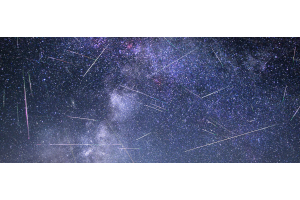
Image Credit: NASA, ESA, CSA, STScI, E. Lieb (University of Denver), R. Lau (NSF NOIRLab), J. Hoffman (University of Denver)
The James Webb Space Telescope, two years into its mission to explore the universe, continues to return astounding images as we head into 2025. The latest images show observations of the star Wolf-Rayet 140 from July and September 2023. These images show a bright white point of light surrounded by regularly spaced “rings”. These rings are, in fact, carbon-rich dust shells around a binary star system. A binary star system, also known as a double star system, is made up of two stars that orbit around a common center of mass. As these two stars swing past one another, their stellar winds collide, creating the impressive rings that you see in the images. These rings, 17 in total in this image, move outwards at an astounding speed of 2,570 kilometers per second.
To give you an idea of how fast this is, the International Space Station moves at about 8 kilometers per second and takes 90 minutes to complete one orbit. If the space station moved at these speeds, it would orbit the Earth in as little as 2-3 seconds.
These stars’ wind creates dust for several months like clockwork every eight years, as the stars make their closest approach to one another. Webb’s images show where the dust formation stops as well. The spread of this carbon-rich dust into the cosmic neighborhood could herald a key ingredient in the formation of solar systems. Wolf-Rayet stars are extremely hot and bright stars that are late stages in the life cycle of very massive stars before they become supernovae. Eventually, these stars will end in a massive supernova, a beautiful stellar event that all massive stars undergo. Supernovas occur when a star exhausts its main nuclear fuel, leading to a core collapse due to immense gravitational forces. This collapse results in a huge explosion that can outshine entire galaxies briefly, dispersing heavy elements into space and leaving behind a neutron star or even a black hole. Wolf-Rayet stars have very strong stellar winds, causing the stars to lose mass as they expel their guts into space, stripping away their outer hydrogen layers to expose their cores. The process results in very distinct emission lines, which astronomers can detect here on Earth.

The two stars of Wolf-Rayet 140 are located 1,518 parsecs away from the Earth in the constellation of Cygnus. Through an amateur telescope on the ground, they have an apparent magnitude of 6.85, making them too faint to be seen with the naked eye but within easy reach of most optical instruments. Although you won’t see the dust production or double star system, an amateur telescope is capable of peering at this system as a point of light among billions of them.

Learn More
Interested in diving deeper into the world of astronomy? Check out our Astronomy Hub for a wealth of articles, guides, local resources for planetariums and observatories near you, and more to enhance your stargazing experience.







